Reactions to Reagan's First Speech on AIDS [pdf]
Celia Hooper, UPI
''This peril that confronts the nation is not comprised of words,'' said Sen. Lowell Weicker, ranking Republican on the Senate appropriations subcommittee that oversees acquired immune deficiency syndrome research.
''It's comprised of very complex viruses and a medical mystery that nobody has been able to unlock, and it ain't going to be unlocked by the speech in Philadelphia by the president,'' Weicker said.
Speaking to reporters following the president's speech Wednesday, Weicker said, ''The most damaging piece of deception as far as the president is concerned is that he says, 'I'm asking for $100 million more in AIDS research.'
''That sounds very good until you hear that he is asking for a $600 million cut in the funds to go to the National Institutes of Health for basic biomedical research. The net of all that is he has cut $500 million for AIDS.''
The National Academy of Sciences, in a special report last October, urged expenditure of $1 billion for AIDS education and $1 billion for research annually by 1990. The report chastised the administration for a lackluster education effort.
Until last week, Reagan delegated visibility on AIDS policy to four physicians at the Department of Health and Human Services: Secretary Otis Bowen, Assistant Secretary Robert Windom, FDA Commissioner Frank Young and Surgeon General C. Everett Koop.
Dr. June Osborn, epidemiologist and dean of the University of Michigan School of Public Health, said she found no surprises in Reagan's comments Wednesday. ''I was sorely disappointed,'' Osborn said. ''The speech signals no change on Reagan's part -- that's the problem. People were looking forward to some federal leadership,'' Osborn said.
In his speech Wednesday, Reagan advocated a modest federal role in AIDS education: ''It must be to give educators accurate information about the disease. How that information is used must be up to schools and parents.''
Reagan stressed instruction in morality as a complement to AIDS education. He told reporters Tuesday that he favored AIDS education ''as long as they teach that one of the answers to it is abstinence-- if you say it's not how you do it, but that you don't do it.''
Stressing the key role of education in the fight against AIDS, Osborn said Reagan's approach to AIDS stood ''in shocking contrast to those of (other) industrialized nations that have frank educational campaigns that assume there are some people who don't practice monogamy and chastity. We owe all citizens-- including those who don't practice monogamy and chastity-- leadership and guidance on AIDS.''
Great Britain, for example, has begun mailing out brochures, posting AIDS warnings on billboards and has been broadcasting AIDS-related messages on television.
Osborn was most critical of a vow Reagan made in his speech: ''I am determined that we'll find a cure for AIDS. ... We'll find a way or make one.''
''He seemed to be saying if we just try hard enough we will get a cure for AIDS,'' Osborn said. ''That's the last thing on the list of promises we should be giving. ... We may never find a cure for the viral disease.''
Fitzwater said Friday that when Reagan referred to a ''cure'' in his speech he was speaking in general terms. ''I think 'cure' was used as a generic word to describe any number of medical solutions to the problem,'' Fitzwater said. ''It was not meant to be a medical term.''
Thomas Stoddard, executive director of the Lambda legal defense and education fund for homosexual issues, said that if Reagan's AIDS speech marked the beginning of a more forthright approach to the issue, ''It is not a promising beginning. His statements were naive and ignorant about AIDS and about the federal government's role in combating the disease.''
Stoddard said that to date only Koop had been ''forthright and frank'' in addressing the AIDS crisis.
''No other official has fully faced up to AIDS,'' Stoddard said. ''He is a hero standing alone.''
Koop has carried a frank anti-AIDS message to audiences across the country, promoting sex education in the early grade school years, and prevention of AIDS through abstinence, monogamy, and for those who practice neither, use of condoms.
His efforts prompted a public scolding in March from conservative Eagle Forum President Phyllis Schlafly and a continuing public disagreement with Education Secretary William Bennett.
The disagreement over AIDS education between Bennett and Koop began in January during a Cabinet-level Domestic Policy Council meeting during which Bennett described the Public Health Service approach as ''morally empty.'' The dispute has since evolved into a gentlemen's agreement to disagree.
Bennett recently told school board officials he doubted the differences would ever be resolved because the issue ''is one where people feel very strongly.''
White House press spokesman Marlin Fitzwater denied that there were major divisions over AIDS within the administration: ''They're coming at it from different perspectives,'' in that Bennett is concerned with educating children and Koop with educating adults about methods.
Koop is approaching it from a public health standpoint, Fitzwater said, while ''Bennett's job is values, education, information, the emotional status'' of AIDS.
Dr. Sidney Wolfe, head of the consumer health group Public Citizen Health Research Group, said, ''If Reagan personally would say the kinds of things that his surgeon general is saying, I would have confidence that (Reagan) is doing more than just deceiving the public.''
''I would rather educate (sexually active) kids while they are alive than pray for them after they're dead as Reagan seems to be doing.''














